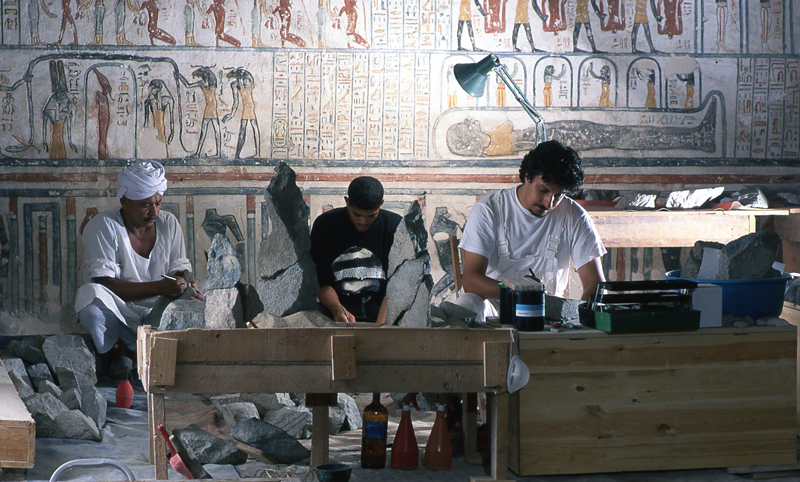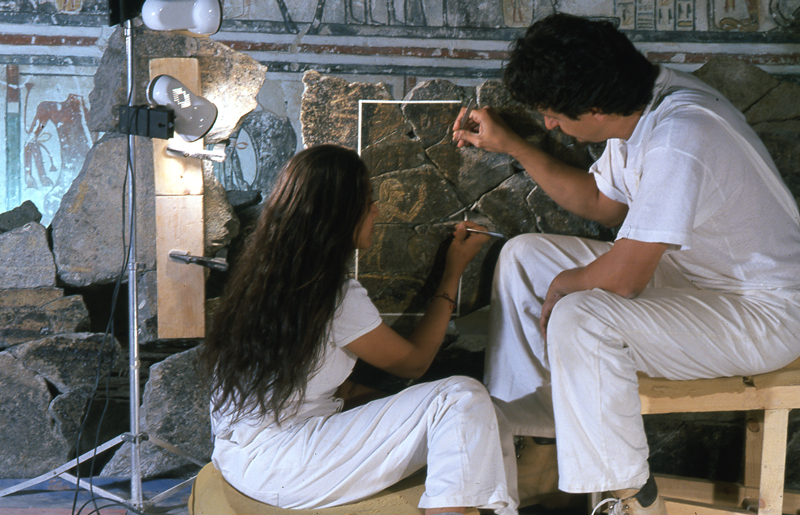- Era20th dynasty
- Project DirectorEdwin C. Brock
- LocationValley of the Kings
- AffiliationAmerican Research Center in Egypt (ARCE)
- Project SponsorUSAID
- Project Dates2001-2005
- Project ImplementerARCE
In 1997, following decades of research and excavation, Egyptologist Edwin Brock applied for funding from the American Research Center in Egypt to reconstruct the shattered remains of the inner sarcophagus of King Ramesses VI. With assistance from the U.S. Agency for International Development, ARCE supported Brock’s restoration work over three seasons to document, clean and reassemble the sarcophagus’ 370 broken pieces.
Brock’s professional and personal passions fueled the project. A former director of the Canadian Institute in Egypt and a previous member of the Theban Mapping Project, Brock dedicated much of his professional life to working on the ground in Luxor, excavating royal tombs in the Valley of the Kings and documenting their remains. He began work in the Valley of the Kings in 1985 at the tombs of Merenptah, Ramesses VI and Ramesses VII. The remains of the inner sarcophagus of Ramesses VI were shattered severely, and this challenge fascinated Brock.
Following many years of research, Brock concluded the sarcophagus had been smashed into pieces during a pre-modern attempt to cut up and recycle the outer sarcophagus that once encased it. The fragments fell into the burial pit above which the sarcophagi once rested. The condition of the smashed sarcophagus worsened over centuries as European explorers poured into Egypt looking for personal souvenirs and items to sell. One of these items was the mask of the inner sarcophagus. Notorious Italian explorer Giovanni Belzoni took the mask for Henry Salt, the British consul-general in Cairo. Salt, in turn, sold it to the British Museum in 1823. This incident, among others, informed Brock of the extent to which the sarcophagus remains had been tampered with over time.
Reconstructing the sarcophagus was a complex process. Brock’s wife and archaeological illustrator Lyla Pinch-Brock created digital renderings based on sketches and photos she had taken of individual fragments in the early 1990s. These renderings were a valuable resource during initial fragment assemblage in 2001, given that much of the decoration of the sarcophagus – that could have helped connect fragments – was obscured by a black resinous layer. Brock later tested and discovered the resin was a ritualistic oil that had been poured over the sarcophagus at the time of burial and blackened as it oxidized.
The team spent the first season assembling the fragments of the sides, base and foot end of the sarcophagus. By starting with this step, Brock could determine the dimensions of the sarcophagus and establish a guide for the assemblies of the sides and foot end. In preparation for assembly, all fragments were cleaned manually with brushes and scalpels to remove dirt and dust build-up. The fragments were affixed with a combination of epoxy adhesives and arranged on four-inch-thick (10 millimeters) stainless steel dowels inserted through the centers.
By the end of the 2001 season, the base of the sarcophagus was complete but the sides and foot end still had many missing fragments. Brock partnered with the conservation department of the British Museum to deliver a fiberglass replica of the sarcophagus mask in time for the 2002 season.
In the first two weeks of the second season, the project finished reconstructing the sides and foot end of the sarcophagus. It reconstructed the right and left sides with epoxy adhesives, tinted lime mortar and a combination of internal fiberglass and stainless-steel stability dowels. The project conservator, Lotfi Khaled Hassan, conducted a test cleaning on the right side of the sarcophagus and removed the black resin to reveal an image of a ba-bird with raised arms. The season ended with the delivery of the mask replica produced by the British Museum, which arrived in Luxor after an eight-hour journey from the Cairo airport strapped atop a Peugeot station wagon.
In 2003, the team filled in gaps in the restored sarcophagus with tinted lime mortar consolidated the lid with epoxy adhesive and arranged the sarcophagus and lid inside the burial chamber. Pinch-Brock spent several days drawing the final arrangements and fragment placements of the lid and the sarcophagus box with a mix of digital photography and hand tracings. And Brock’s photographer, Francis Dzikowski, photographed the entire chamber and the newly restored sarcophagus and lid.
Nearly two decades after he began his initial excavations in Ramesses VI’s tomb, Brock saw finally the fruits of his labor. The physical reassembly of the sarcophagus was an impressive feat, but the significance of the project went much deeper for Brock.
“Restoring the mummiform sarcophagus of Ramses VI was largely driven by my desire to provide an overall understanding of the archaeology of the cemetery,” he explained in his project notes, adding that the project highlighted the millennia of interference and damage caused by looters, explorers and pre-modern tourists in the Valley of the Kings.
On March 21, 2004, Minister of Culture Farouk Hosni and Secretary General of the Supreme Council of Antiquities Zahi Hawass reopened the tomb of Ramses VI. The tomb and its restored sarcophagus remain one of the most popular sites in the Valley of the Kings. It not only serves as a legacy to Edwin Brock and his career, but as a testament to ARCE’s commitment to, and impact on, the preservation of Egypt’s irreplaceable cultural heritage.




